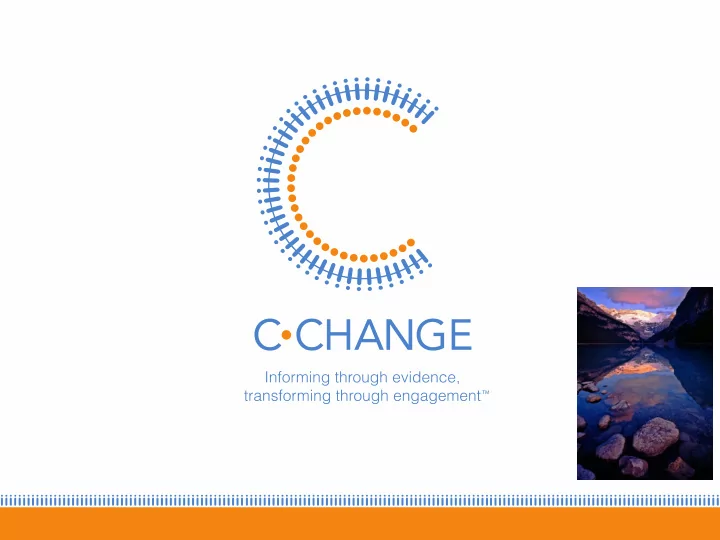

Harmonization of Guidelines: The C-CHANGE Initiative C anadian C ardiovascular HA rmonization of N ational G uidelines E ndeavour
• Acknowledgements • Jacques Genest, Rob Welsh • Evidence-Based Marketing • National CPG Committee Memberships • Disclosures • Speaker/Advisory Board Honorariums • Research Funding - Sanofi • National CPG Committee Memberships • Canadian Diabetes Association 2013 • Canadian Cardiac Rehabilitation Cardiac Rehabilitation (Chair) • Canadian Hypertension Education Program • C-CHANGE (Canadian Cardiovascular HArmonization of National Guidelines Endeavour) (Chair) • CCS Dyslipidemia 2102 • CCS Smoking Cessation 2011 • CCS Committee on Chronic Stable Angina • CIHR Committee on Refractory Angina • Physical Activity for Adults 2011 • Physical Activity for Persons with Spinal Cord Dysfunction (Chair) 2011
Overview • Who is C-CHANGE? • What is the history of C-CHANGE? • Why is C-CHANGE important? • What are the consequences of not realizing C-CHANGE? • The Update Process
CPGs: Reality or Illusion?
Who is C-CHANGE?
C-CHANGE Partners 1. Canadian Association of Cardiac Rehabilitation 2. Canadian Diabetes Association 3. CCS Dyslipidemia Guidelines Group 4. Canadian Hypertension Education Program 5. Canadian Stroke Network 6. Canadian Society for Exercise Physiology 7. CCS Smoking Cessation Working Group 8. Obesity Canada 9. CCS Anti-Platelet Guidelines 10. CCS Heart Failure Guidelines 11. CCS Atrial Fibrillation Guidelines 12. CCS Stable Ischemic Heart Disease Guidelines
What is the History of C-CHANGE? Why do we need Integrated CPGs?
C-CHANGE History • 2002 – Campbell and Stone – September 2002 – SOLIDDE • 2003 – 2007 – Six meetings • 2008 – CIHR • Canadian Vascular Coalition – CPG Development
C-CHANGE History • 2010 – June – Harmonization Meeting • 2011 – C-CHANGE Publication • 2014 - Update
C-CHANGE History • 2010 – June – Harmonization Meeting • 2011 – C-CHANGE Publication • 2014 - Update
Why IS C-CHANGE Important?
Why is C-CHANGE Important? • Clinical Leadership – Knowledge of science leads to expertise in the art • Thought Leadership – Visionaries – Work horses – Collaborators • Research Leadership – Basic science – Clinical trails – Outcomes assessments • Primacy of Evidence-Informed Clinical Practice – Evidence informs experience – Enhanced experience leads to enhanced outcomes
What are the Consequences of Not Realizing C-CHANGE? “ All for One and One for All! ”
No C-CHANGE: Consequences • CPG anarchy – Competition for markets – Competition for funding – Competition for development stakeholders – Fragmentation of: • Prevention • Chronic disease care • Teaching and education • Sub-optimal patient outcomes • Primacy of practice-informed clinical practice – Experience is more important than evidence – Return to eminence-based practice • Recommendation Redundancy
Recommendation Duplication Nutrition Source Guideline Recommendation (Location) CDA (Health In diabetes Adults with diabetes should consume no more than 7% of Behaviour total daily energy from saturated fats and should limit intake of trans Interventions) fatty acids to a minimum. (Grade D, Consensus) Obesity Canada A high-protein or a low-fat diet (within acceptable macronutrient (Health distribution ranges indicated in the Dietary Reference Intakes) is Behaviour suggested as a reasonable short-term (6 – 12 months) treatment option Interventions) for obese adults as part of a weight-loss program. (Grade B, Level 2) Obesity Canada Meal replacements may be considered as a component of an energy- (Health reduced diet for selected adults interested in commencing a dietary Behaviour weight-loss program. (Grade C, Level 2) Interventions)
No C-CHANGE: Consequences
Harmonized Recommendations Translating Scientific Knowledge into Clinical Action
Recommendation Categories Diagnostic • Screening • Risk Stratification • Diagnostic Tests Therapeutic • Treatment Targets • Health Behaviour Therapies • Pharmacological Therapies
The Update Process
C-CHANGE Update Process 1. Harmonize specific recommendations - same wording 2. Do not increase the workload 3. Implementation tools must adhere strictly to the recommendations 4. All C-CHANGE implementation tools will have C-CHANGE branding 5. Recommendations development - include an implementability wording
C-CHANGE Update Process 6 . Harmonized C-CHANGE recommendations reviewed annually 7. Guidelines development requires AGREE II 8. Bias reduction remains a constant priority 9. Core C-CHANGE implementation tools will not have industry support 10. Primary care physicians and allied health care professions: Recommendation Development Implementation Tool Development
SUMMARY
SUMMARY • Who is C-CHANGE? • What is the history of C-CHANGE? • Why C-CHANGE important? • What are the consequences of not realizing C-CHANGE? • The Update Process
SUMMARY • The KT Ripple Effect – The Council of The Federation – Alberta Vascular Risk Reduction Project
Summary
Recommend
More recommend